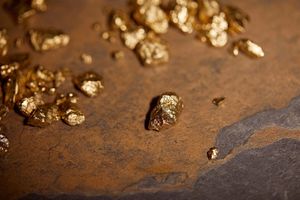
The global financial landscape is currently experiencing a profound shift as escalating geopolitical uncertainties drive an unprecedented demand for traditional safe-haven assets, particularly gold and silver. This flight to tangible assets is propelling the prices of these precious metals to record highs, fundamentally reshaping investment strategies and signaling a deep-seated apprehension among investors about the stability of conventional financial markets. The ongoing conflicts, trade disputes, and power realignments across the globe are creating a fertile ground for precious metals to reassert their historical role as ultimate stores of value.
What Happened and Why It Matters: A Retreat to Tangible Wealth
In recent months, a confluence of geopolitical flashpoints has triggered a significant surge in the appeal of gold and silver. The accelerated US arming of Israel and the reconfiguration of military alliances in the Middle East, coupled with a united response from several Islamic countries, have dramatically heightened global risk aversion. Simultaneously, persistent conflicts in Eastern Europe, including the protracted Russia-Ukraine war and recent Russian incursions, continue to fuel widespread uncertainty. These overt conflicts are compounded by simmering trade disputes between major economic powers, such as the US and China, which threaten global supply chains and economic stability. The rapid reshaping of regional powers and a growing movement towards de-dollarization, with nations accumulating gold reserves to reduce reliance on the US dollar, further underscore a systemic shift in global financial architecture. Additionally, political instability within major economies, like governmental challenges in European countries, eroding confidence in traditional financial institutions and currencies, directing capital towards the perceived safety of gold and silver.
This environment of pervasive uncertainty has had an immediate and dramatic impact on precious metal prices. Spot gold has shattered previous records, peaking near $3,790.82 per ounce in September 2025, marking a year-to-date increase of over 40%. US gold futures have similarly surpassed the $3,800 mark. This monumental rally is not merely speculative; it is underpinned by robust safe-haven demand, aggressive central bank buying, and persistent inflationary pressures. Silver has mirrored this upward trend, nearing a 14-year high at $43.58 per ounce in New York, with Shanghai silver setting new historical records above 10,150 yuan. Silver's surge is driven by a combination of speculative sentiment, robust industrial demand from sectors like solar energy and electric vehicles, and its inherent safe-haven appeal, often exhibiting greater price elasticity than gold. The current gold-silver ratio, significantly higher than its historical average, suggests further potential for silver appreciation.
The Market's Shifting Sands: Who Wins and Who Loses?
The ripple effects of this safe-haven surge are profoundly impacting financial markets, leading to increased volatility and a notable flight to safety. Capital is being diverted from riskier investments like stocks and bonds into the perceived stability of precious metals. Major geopolitical events typically trigger stock market declines, with emerging markets often experiencing more severe drops. Weaker earnings growth, high market valuations, and foreign investor selling further weigh on equities, while gold and silver benefit from this capital reallocation.
Furthermore, geopolitical conflicts and political unrest can lead to the devaluation of national currencies. Investors increasingly turn to gold as a hedge against currency fluctuations and persistent inflationary pressures, as gold maintains an intrinsic value independent of government financial stability or corporate performance. Rising oil prices, frequently a consequence of geopolitical tensions, also signal inflation, further bolstering demand for precious metals. This environment underscores the critical importance of portfolio diversification, with gold, in particular, acting as a key diversifier due to its limited correlation with traditional financial markets during periods of turmoil.
This dynamic creates clear winners and losers across various industries:
Winners:
- Precious Metals Mining Companies: Companies involved in gold and silver extraction are direct beneficiaries of soaring commodity prices. Companies like Barrick Gold (GOLD: NYSE), Gold Royalty Corp. (GROY: NYSE), Miata Metals Corp. (MMET: CSE), Abcourt Mines Inc. (ABI: TSXV), Aurion Resources Ltd. (AU: TSXV), and B2Gold Corp. (BTO: TSX) are seeing boosted revenues and profits, potentially leading to increased exploration activities.
- Investment Firms and ETFs: Firms managing precious metals exchange-traded funds (ETFs) and investment funds are experiencing increased inflows as institutional and retail investors shift towards these safe havens.
- Defense and Energy Sectors: Companies in the defense or energy sectors may see a bounce in their share prices following geopolitical shocks, especially military conflicts, due to increased demand for their products and services.
Losers:
- Jewelers: The soaring costs of gold and silver are leading to a decline in consumer demand for traditional precious metal jewelry. Jewelers such as Tiffany & Co. (TIF: NYSE) (now part of LVMH) and Signet Jewelers Limited (SIG: NYSE) must adapt by focusing on more affordable alternatives, minimalist designs, or promoting recycling initiatives.
- Industrial Users of Silver: High-growth sectors like solar panels, electronics, and electric vehicles, which rely heavily on silver, face rising input costs. While industrial demand for silver remains robust, sustained high prices could incentivize innovation in material substitution or efficiency improvements, potentially impacting future demand for silver in these applications.
- Companies in Targeted Sectors: Businesses in sectors subjected to trade tariffs or economic sanctions can face significant losses due to disrupted supply chains and reduced market access.
Broader Implications: A Fundamental Reassessment
The current geopolitical climate is not just causing temporary market fluctuations; it is fundamentally reshaping the precious metals industry and the global financial system. The sustained rally signifies a profound reassessment of gold's role, reasserting its traditional function as a hedge against inflation and economic uncertainty.
A critical factor providing structural support for gold prices is the aggressive buying by central banks, particularly from emerging economies. These nations are actively seeking to diversify their reserves away from the US dollar and mitigate both geopolitical and monetary risks. Net purchases have consistently exceeded 1,000 metric tons annually since 2022, with similar levels projected for 2025. This institutional demand creates a robust price floor, sustaining higher prices for the foreseeable future.
Silver's unique position as both a safe-haven asset and a critical industrial metal (used extensively in solar energy, electric vehicles, and semiconductors) makes it particularly sensitive to broader economic narratives. Strong industrial demand, coupled with persistent supply stagnation, is creating a deepening market deficit for silver, projected to reach 117.7 million ounces in 2025 and potentially doubling to 265 million ounces. This structural imbalance could sustain elevated prices for the foreseeable future, potentially leading to "commodity supercycles" that benefit silver disproportionately. This represents a fundamental shift in investor sentiment, characterized by a widespread flight to tangible assets amidst increasing global economic and geopolitical turbulence.
Historically, precious metals have consistently served as safe havens during periods of geopolitical uncertainty. Examples include the Gulf War (1990-1991), where gold prices increased by approximately 15%; the September 11 attacks (2001), which saw a 5% jump in gold; the Iraq War (2003), where gold gained about 6%; and the 2008 Financial Crisis, during which gold prices soared as investors sought refuge from volatile stock markets. More recently, the Crimea annexation (2014) led to a 12% rise in gold, and the COVID-19 pandemic (2020) helped drive gold to then-record highs. The 1970s oil crisis and the Russia-Ukraine war (2022) also saw significant gold price increases, while silver provided a safe haven during the 2023 banking crisis. These historical patterns reinforce the perception of gold and silver as reliable stores of value during periods of political instability, economic downturns, and currency devaluation.
What to Pay Attention to Next: Navigating the New Normal
Looking ahead, the trajectory of precious metals will largely depend on the evolution of current geopolitical tensions and the responses of central banks worldwide. In the short term, any further escalation of conflicts in the Middle East or Eastern Europe, or intensified trade disputes, will likely provide additional impetus for gold and silver prices. Central bank monetary policy, particularly interest rate decisions by the US Federal Reserve, will also play a crucial role. Dovish policies or declining real yields tend to boost the attractiveness of non-yielding assets like gold.
In the long term, the structural demand from central banks and the deepening market deficit for silver are powerful forces that could sustain elevated prices. This presents significant market opportunities for investors seeking to diversify their portfolios and hedge against future uncertainties. Precious metals mining companies may continue to benefit from increased exploration and production, while industrial users of silver will need to innovate to manage rising input costs. Potential scenarios include a continued upward trend for both gold and silver, with periods of consolidation, driven by persistent geopolitical instability and a global reassessment of fiat currency risks.
Conclusion: A Durable Shift in Investment Philosophy
The current surge in safe-haven demand for gold and silver is more than a temporary market reaction; it signifies a durable shift in investment philosophy driven by an increasingly uncertain geopolitical landscape. The record-breaking prices of these precious metals underscore their enduring role as hedges against inflation, currency devaluation, and systemic risk. The confluence of escalating conflicts, trade tensions, de-dollarization efforts, and central bank buying has created a powerful bullish environment for gold and silver.
Moving forward, investors should closely monitor geopolitical developments, central bank policies, and the dynamics of industrial demand for silver. The resilience and continued appreciation of precious metals highlight their importance as foundational components of a diversified investment portfolio in an era defined by volatility and uncertainty. The market is clearly signaling a preference for tangible assets, and this trend is likely to persist as global power dynamics continue to evolve.
This content is intended for informational purposes only and is not financial advice




